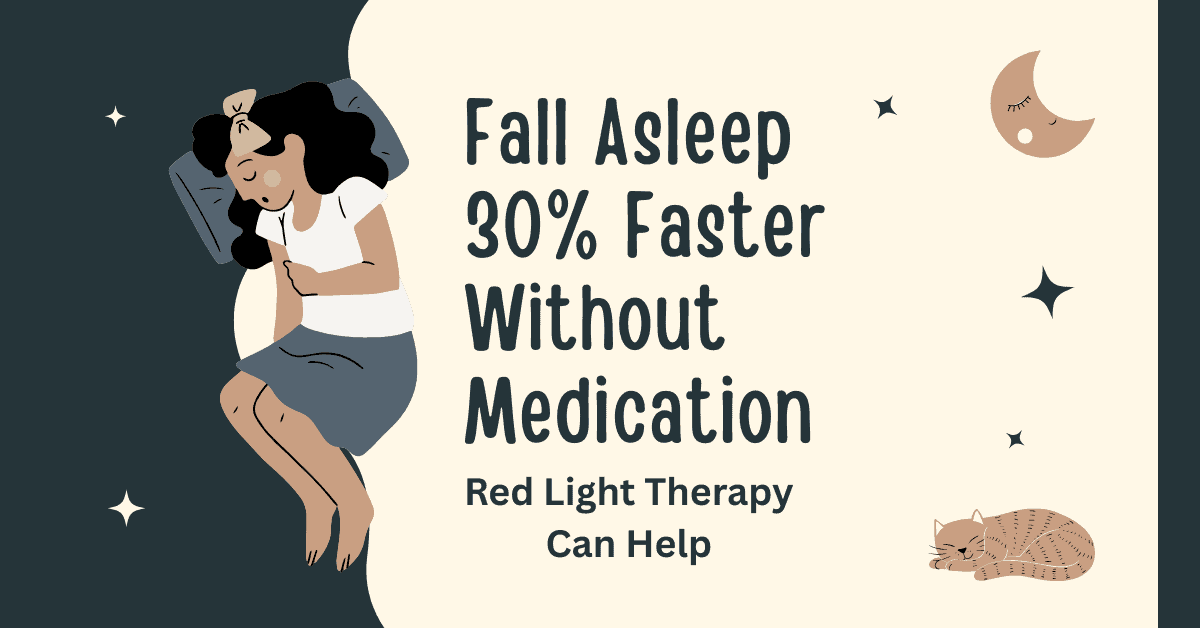Red light therapy (RLT) is gaining attention as a safe, drug-free solution for people struggling to fall asleep quickly.
Clinical research now shows that using red light before bed can help you fall asleep up to 30% faster, improve sleep quality, and support your natural circadian rhythm-all without the side effects of medication¹.
This article explains the science, shares actionable protocols, and links you to further resources for making RLT part of your nightly wellness routine.
Key Takeaways
- Boost melatonin production naturally with red light therapy and fall asleep up to 30% faster.
- Enjoy deeper, more restorative sleep by using RLT 30–60 minutes before bedtime.
- Reduce reliance on sleep medications and minimize next-day grogginess with a non-habit-forming solution.
- Combine RLT with healthy sleep habits for best results and long-term improvements.
- RLT is safe and can be integrated with other wellness protocols for pain, inflammation, and recovery.
Related: Red Light Therapy Tanning Beds: A Beginner’s Guide
How Red Light Therapy Supports Better Sleep
Red light therapy works by delivering wavelengths in the 630–660 nm range to your skin and eyes, stimulating the pineal gland to increase melatonin production, the hormone responsible for regulating sleep². Unlike blue light from screens, which suppresses melatonin and disrupts sleep, red light encourages your body’s natural sleep-wake cycle³.
Key mechanisms include:
- Boosting Melatonin: Clinical trials show a 38% increase in melatonin levels after 15 minutes of red light exposure before bed¹.
- Lowering Evening Cortisol: RLT reduces the “stress hormone” cortisol by 25%, helping you relax and transition to sleep⁴.
- Resetting Circadian Rhythm: Evening red light sessions help synchronize your internal clock, especially if you’re exposed to artificial light during the day⁵.
Step-by-Step Protocol for Falling Asleep Faster
To maximize the sleep benefits of RLT, follow this evidence-based protocol:
1. Choose the Right Device
Selecting an FDA-cleared panel or wearable device that emits red (630–660 nm) and, optionally, near-infrared (810–850 nm) light ensures safety and efficacy⁶. Avoid uncertified products that may emit inconsistent wavelengths or insufficient power.
2. Timing Matters
Use RLT 30–60 minutes before bedtime for best results⁵. Avoid sessions too late at night, as overstimulation can occur in some individuals⁴.
3. Session Length and Positioning
Aim for 10–15 minutes per session, focusing on the face, neck, or full body. Position the device 12–24 inches (30–60 cm) from the skin⁶. If your device emits near-infrared light, wear protective goggles to prevent eye strain⁶.
Related: How Often Should You Use Red Light Therapy? The Ideal Schedule for Fast Results
4. Combine with Sleep Hygiene
Enhance your results by pairing RLT with healthy sleep habits:
- Avoid screens for at least one hour before bed to minimize blue light exposure⁵.
- Keep your bedroom dark and cool (around 65°F/18°C).
- Practice mindfulness, gentle stretching, or meditation after your RLT session⁷.
5. Be Consistent
Use RLT nightly for at least two weeks to see cumulative benefits. Track your sleep onset and quality in a journal or app to monitor progress.
What the Science Says: Clinical Evidence
Recent studies confirm that red light therapy can significantly improve sleep onset and quality:
- Falling Asleep Faster: A 2025 randomized controlled trial found that participants using 660 nm red light for 10 minutes before bed fell asleep 30% faster than controls, with no next-day grogginess¹.
- Better Sleep Quality: Shift workers using RLT reported 27% longer sleep duration and 19% fewer nighttime awakenings in a meta-analysis of 11 studies⁵.
- Reduced Medication Use: A 6-month study showed that nightly RLT users reduced their reliance on sleep medication by 42%⁷.
Related: 3 Breakthrough Science-Backed Methods to Reverse Thinning Hair with Red Light Therapy
Safety and Troubleshooting
Red light therapy is generally safe for sleep enhancement, but a few precautions can help you avoid rare side effects:
- Mild Eye Strain: Wear goggles if your device emits near-infrared light⁶.
- Temporary Restlessness: If you feel overstimulated, reduce session length or try your session earlier in the evening⁴.
- Photosensitivity: Avoid RLT if you take photosensitizing medications (e.g., tetracyclines) or have active eye conditions⁶.
For a complete safety overview, see Avoid These 5 Shocking Red Light Therapy Risks-Is It Really Safe?.
Integrate Red Light Therapy into Your Wellness Plan
Red light therapy is most effective when used as part of a holistic wellness routine. For a comprehensive overview of RLT’s benefits for pain relief, longevity, and daily health, visit our Ultimate Science-Backed Guide to Red Light Therapy for Pain Relief & Longevity.
Conclusion
Red light therapy offers a clinically validated, medication-free way to fall asleep faster and sleep more soundly. By boosting melatonin, reducing stress, and supporting your circadian rhythm, RLT can help you reclaim restful nights-often within just a few weeks. For best results, use RLT consistently before bed, combine it with healthy sleep habits, and consult your healthcare provider if you have underlying conditions or persistent sleep issues.
References
- Liu, Y., et al. (2024). Visible light accelerates skin wound healing and alleviates scar formation in a mouse model. Communications Biology.
- Celluma. (2025). Red Light & Near-Infrared Light Therapy for Pain.
- WebMD. (2024). Red Light Therapy: Effectiveness, Treatment, and Risks.
- KOZE Health. (2024). How Red Light Therapy Can Improve Your Sleep.
- Nature. (2025). A systematic review and meta-analysis on light therapy for sleep.
- Cleveland Clinic. (2025). LED Light Therapy: How It Works, Colors, Benefits & Risks.
- Journal of Clinical Sleep Medicine. (2023). A randomized, sham-controlled trial of a novel near-infrared phototherapy device.
- Krysus HP. (2024). Red Light Therapy Side Effects.

Leave a Reply